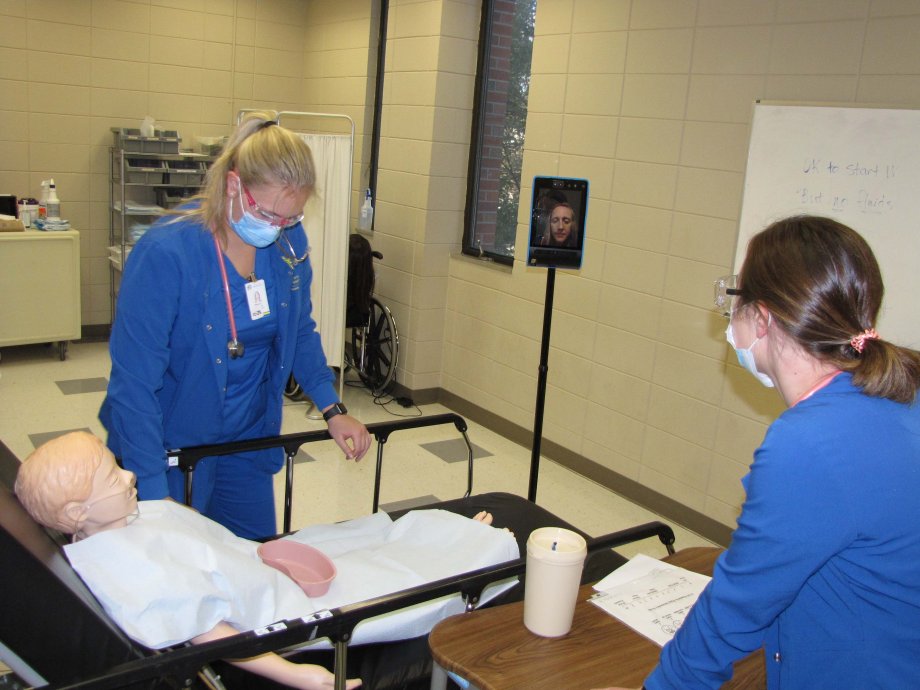
When COVID-19 had Nicole Carlson quarantined at her Sioux Falls home, the South Dakota State University nursing instructor didn’t have to miss watching her students perform basic skills in the college’s simulation lab in Brookings.
Thanks to a telepresence robot purchased through funding from the federal Health Resources and Services Administration, Carlson was right there with the students. In fact, she was playing the part of the mother of the 3-year-old simulation mannequin. Before this fall, Carlson would have had to find a colleague to cover the lab exercises and rely on that report.
“Nursing is defined by the connection we have with patients, families and other healthcare providers,” Carlson said. “I love interacting with the students via the robot because I am still able to maintain that connection by having a conversation, asking questions and observing the student responses.
“In the current pandemic, health care providers must rely even more on technology, so my role as a family member connecting via technology is relevant now more than ever. The use of this technology prepares our students for their careers.”
The telepresence robot is one of 10 purchased through a $78,000 grant that was aimed to address issues brought about by the COVID-19 pandemic.
The 10, purchased through Double Robotics, are distributed among the college’s sites in Brookings, Sioux Falls, Aberdeen and Rapid City. The college also plans to use $20,000 of the HRSA award to purchase telehealth equipment, according to Heidi Mennenga, an associate professor in Brookings who is the project director for a 2018 HRSA award.
That $2.7 million award for 2018-2022 is targeted at more fully utilizing registered nurses and students in community-based primary care settings. It is because of that HRSA funding that SDSU was eligible to receive the HRSA COVID-19 funding, Mennenga said.
The robots arrived in mid-October and SDSU may be the only nursing program in the state to be so equipped, Mennenga said.
However, the robots, which look like a tablet camera with a selfie stick on wheels, have been used in other educational settings. Leann Horsley, associate dean for SDSU nursing in Sioux Falls, was familiar with their use at Duke University. Duke gave the robots a favorable recommendation when SDSU quizzed its officials.
Compliments have also come from SDSU students who have used the robots.
Student raves about robot
Alex Stout, a fourth-semester nursing student from Brookings, was in quarantine from COVID-19 when he experienced the robot in late October.
“During the simulation, my role as the recorder was to write down everything that happened during the experience, whether that be medications pushed at a certain time, what time the code started, how many times we had pushed a certain medication, and when you could push that medication again,” Stout said.
In another simulation, his role was the observer.
“I was just able to watch what my peers did and take notes on how I thought the simulation went. In person, these tasks would have been done the same way but I would have just been present in the room taking notes on pencil and paper,” he said.
What’s the learning curve to use the telepresence robot?
Stout said, “It took me about three minutes and then I felt as if I was a pro using the robot. The software is very easy to use and worked well. I would most definitely be willing to use the robot again. I enjoyed being able to complete the simulation with my peers and get almost the same experience they did while sitting in my home.
“I think it was great and will continue to be a great addition to the nursing program.”
Has uses after COVID-19 wanes
Mennenga said Stout’s response is typical. “There is a general excitement of something new we get to use. Students are pleased with the ease of navigation and having it as an option. Anything we can do to get a student involved in simulation is a positive.”
Any personal computer can operate the robot and it can move by a simple click of the computer’s arrow keys.
So far, the robot has only been used in the simulation lab. However, it could be used in a classroom when the instructor couldn’t be present.
Also, Mennenga said student nurses are not currently allowed in nursing homes or care facilities because of the COVID-19 pandemic. Students could possibly use the robot to participate in care conferences and other observations at such facilities.
Another possibility is using the robots in care settings in which students may have limited opportunities, such as intensive care units, emergency rooms and labor and delivery.
Mennenga said, “The biggest difficulty is getting the approval of IT departments in clinical facilities. Bringing in that external technology can be a concern for facilities. That will be a process. We will wait until faculty and students get more comfortable, then we’ll make that step.”
Given initial responses to the robot, it may not be long before taking that step. “It’s a really neat device,” Carlson said.
- Contact:
- Telephone number: 605-688-4538
Republishing
You may republish SDSU News Center articles for free, online or in print. Questions? Contact us at sdsu.news@sdstate.edu or 605-688-6161.

